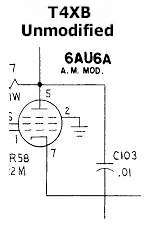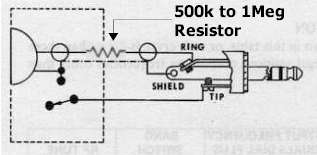Drake Home Page Drake Technical Tips Menu
![]()
T4X Series AM Mode Modification
Written by: Mark Gilger, WB0IQK
|
Authors Note: This article applies to the T4XB and T4XC models only The stock T4XB series transmitters are designed to put out a 5-8 watt carrier when no modulation is applied. The T4XC is slightly higher 8-15 watts. This is also called the resting carrier. When modulating, the unit will increase to maximum power. The problem with this method of modulation, called controlled carrier, is that a lot of the older AM receivers do not handle it well. It is often referred to as pumping. To prevent pumping, you need to raise the resting carrier to point where the pumping action is damped. This can be handled by a very simple modification to the 6AU6A A.M. modulator common to all of the T4X series transmitters. The schematic below, is actually a stock T4XC A.M. modulation section, except that the 220 ohm R63 cathode resistor has been replaced by a variable 1K ohm potentiometer. The Pot is mounted on the rear of the chassis in one of the spare holes, which were meant for RCA expansion jacks.
|
||
|
T4XB Modifications: ● Locate the 6AU6A modulator tube V11. ● Cut the ground off of pin#2 of the V11 ● Cut the wire that is currently connected to Pin #7 of V11. ● Mount a 1K ohm pot on the rear chassis in a spare RCA plug hole. ● Run a wire from pin #7 of V11 to a 1k ohm pot center pin (wiper) post. ● Run a wire back from the either of the end post of the pot, to the wire that was disconnected in step 3. ● Solder a wire to the two wires connected up in step 6 over to Pin #2. |
 |
|
| T4XC
Modification: ● Cut the resistor R63 off of pin #7 of V7. ● Tape up the loose end of R63 to prevent it from shorting out later on. ● Mount a 1K ohm pot on the rear chassis in a spare RCA plug hole. ● Run a wire from the Pin 2 to the center post of the new pot. ● Run a wire back from the either of the end post of the pot, to the pin 7 of V7. This bypasses R63 and replaces it with the new 1K ohm pot. |
|
|
|
Adjustment Procedure: ● Tune up for maximum power on SSB. ● Switch the function switch to X-AM. ● Make sure the Sideband switch is in Lower – X position. ● Press the PTT switch and adjust the pot for an output of between 10 & 30 watts. |
||
Microphone Recommendations: ● D-104’s or Shure 444’s work very good with all Drake equipment. ● The T4X series are looking for a high impedance input from the mic. The D-104 and Shure 444 are high impedance. ● If you receive reports indicating you do not have enough lows in your audio, place a 500k – 1 meg. ohm resistor in series with the mic element hot lead, typically the red wire coming direct from it’s element. |
||
|
Cooling Recommendations: ● AM operation will cause the 6JB6 finals to generate a lot of heat. A cooling fan will be needed to prevent tube life decay. ● Mount the fan either on top of the finals or on the rear amplifier cage with the air flow pulling out. ● The fan can be either AC or DC. If using AC, use a 220 volt ac muffin fan. When running on 115 volts it will run at half speed and be very quite. A 12 volt, PC type fan also will work very nice. 12 volts can be obtained from installing a half wave rectifier on the 12 volt filament string located at many locations. ● If the fan is to be positioned on the top of the cabinet. Attach the self adhesive rubber feet to each corner of the fan. This will prevent the fan from scratching the paint. ● If the fan is to be mounted on the rear of the amplifier cage, it can be mounted using several tie wraps through the cage holes. |
||
|
Operating Recommendations: ● When operating AM, the T4X series transmitters will shift the transmit frequency about 1 to 1.5 KC. This is done to position the AM signal in the middle of the transmitter crystal filter, which is still in the circuit. It’s best to run split mode letting the transmitter control the transmitter and the receiver the receiver. With a frequency counter sniffing the A.M. carrier, you can get right on frequency. ● If you do not make compensation for the offset, you will be transmitting 1 – 1.5 KC off of the other stations frequency and he will have to tune off frequency for best copy.
|
||